Abstract
Human proliferating cell nucleolar antigen p120 is expressed in tumor cells in the early G1 phase of the cell cycle. Deletion analyses of the essential cis-acting region -537/-278 showed that a 58 bp sequence from -457 to -400 is an important cis-acting element. An Sp1 transcription factor binds to the sequence AGAGGCGGGG (-425 to -416) within the -458/-400 cis-acting region. Deletion of the Sp1 binding sequence eliminated transcription. Substitution of the Sp1 box(-437/-406), containing the Sp1 recognition site, for the entire cis-acting region (-537/-278) restored transcription only at a very low level (18%). Deletion of the -537/-278 cis-acting region followed by substitutions showed that the Sp1 box (-437/-406) stimulated transcription 2.4 fold, when juxtaposed and downstream of a 35 bp (-472 GGGCGAGCGTAAGTTCCGGGTGCGGCGGCCGACTA -438) positive regulatory cis-element (PRE) over that by substitution of the Sp1 box alone. When the -406/-278 sequence was downstream of the PRE-Sp1 box, transcription was stimulated 4.4 fold over that produced by substitution of the Sp1 box alone. These results suggest that Sp1 is essential and its proper position in the 5' flanking sequence, juxtaposed and down stream of a 35 bp positive regulatory sequence, is required for efficient transcription.
Full text
PDF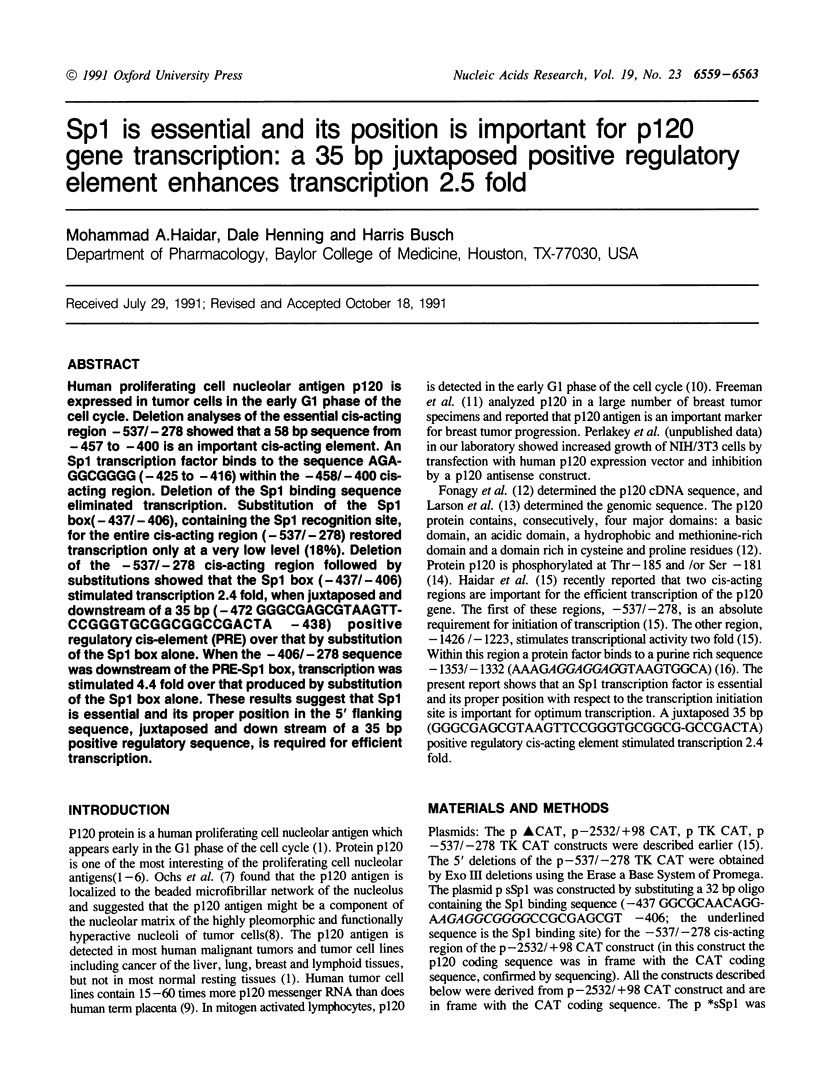
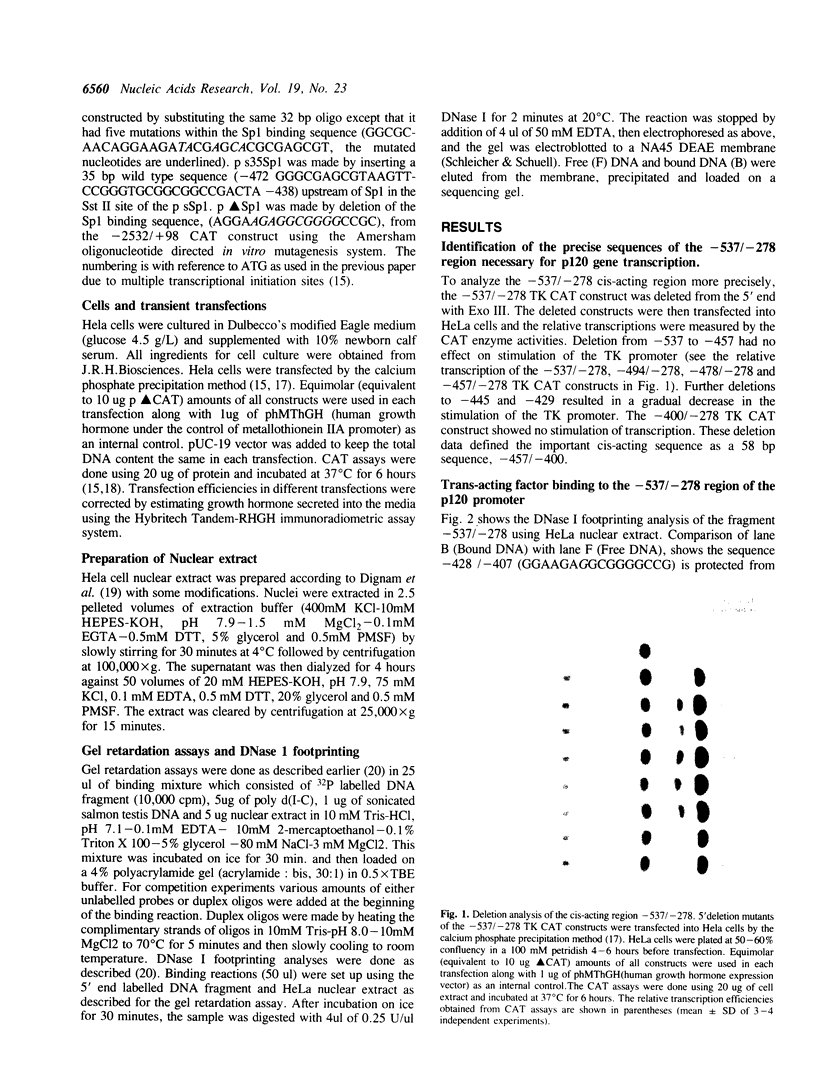
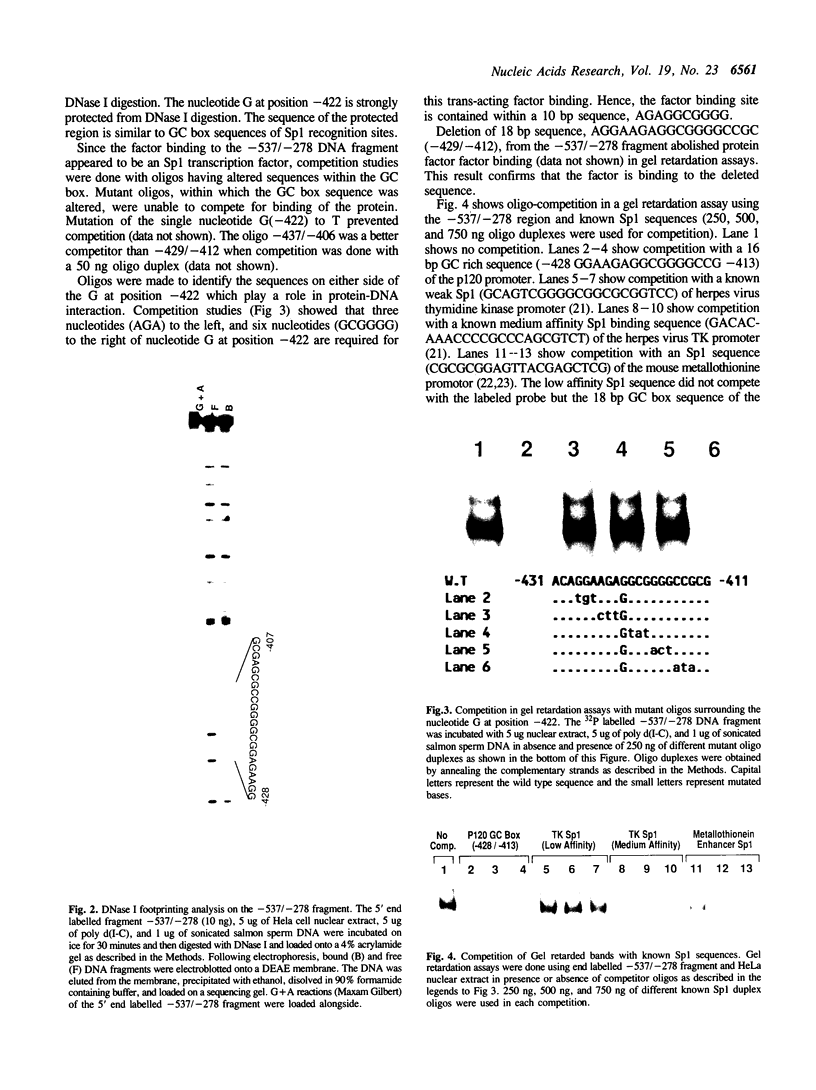
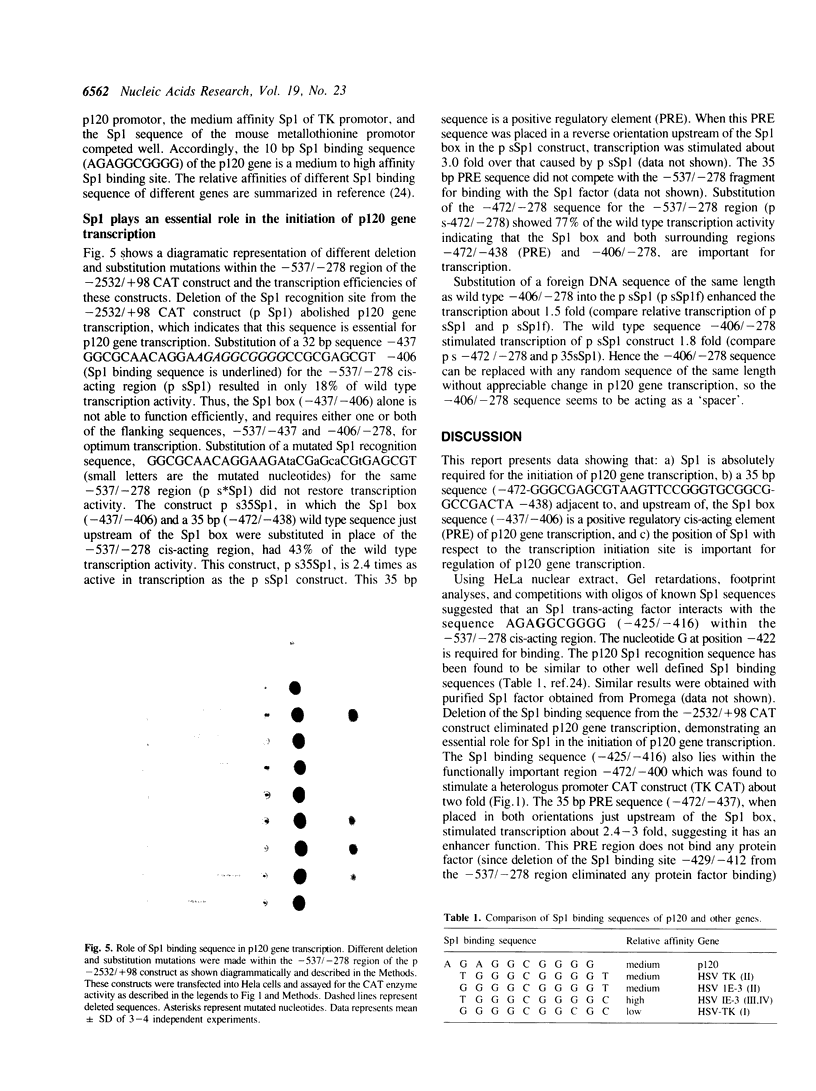
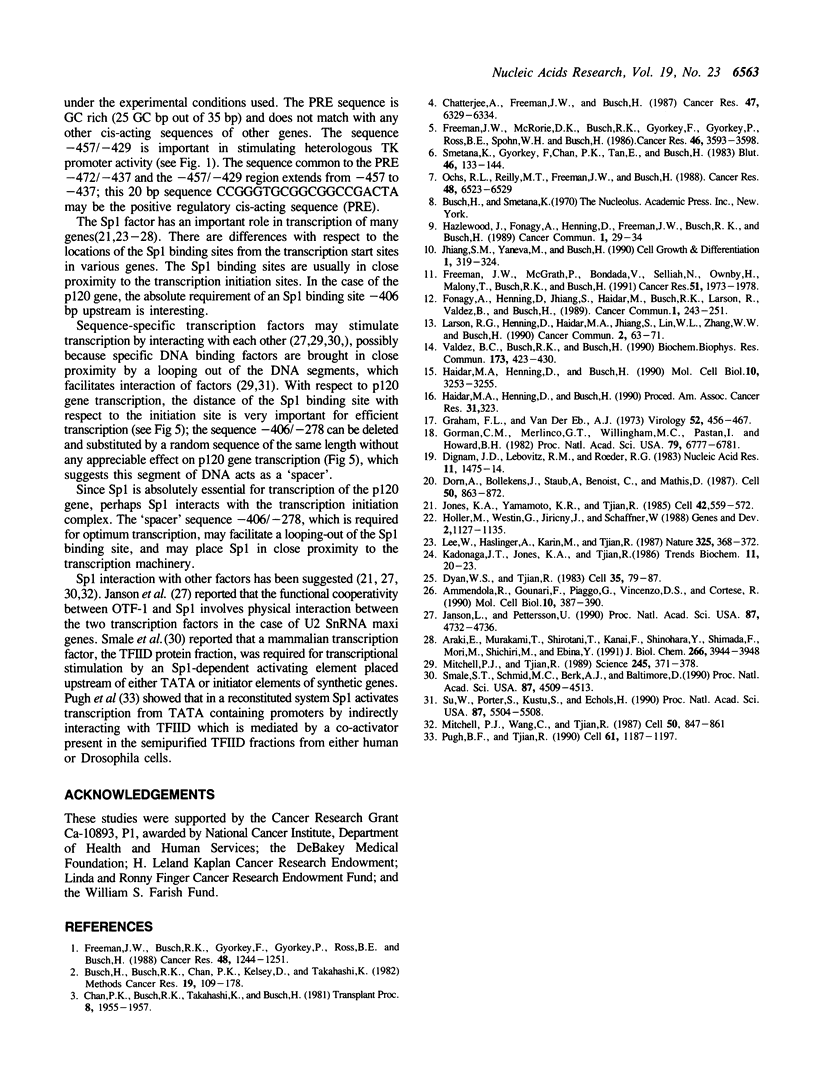
Images in this article
Selected References
These references are in PubMed. This may not be the complete list of references from this article.
- Ammendola R., Gounari F., Piaggio G., De Simone V., Cortese R. Transcription of the promoter of the rat NF-1 gene depends on the integrity of an Sp1 recognition site. Mol Cell Biol. 1990 Jan;10(1):387–390. doi: 10.1128/mcb.10.1.387. [DOI] [PMC free article] [PubMed] [Google Scholar]
- Araki E., Murakami T., Shirotani T., Kanai F., Shinohara Y., Shimada F., Mori M., Shichiri M., Ebina Y. A cluster of four Sp1 binding sites required for efficient expression of the human insulin receptor gene. J Biol Chem. 1991 Feb 25;266(6):3944–3948. [PubMed] [Google Scholar]
- Chan P. K., Busch R. K., Takahashi K., Busch H. Purification of human tumor nucleolar antigens to electrophoretic homogeneity. Transplant Proc. 1981 Dec;13(4):1955–1957. [PubMed] [Google Scholar]
- Chatterjee A., Freeman J. W., Busch H. Identification and partial characterization of a Mr 105,000 nucleolar antigen associated with cell proliferation. Cancer Res. 1987 Dec 1;47(23):6329–6334. [PubMed] [Google Scholar]
- Dignam J. D., Lebovitz R. M., Roeder R. G. Accurate transcription initiation by RNA polymerase II in a soluble extract from isolated mammalian nuclei. Nucleic Acids Res. 1983 Mar 11;11(5):1475–1489. doi: 10.1093/nar/11.5.1475. [DOI] [PMC free article] [PubMed] [Google Scholar]
- Dorn A., Bollekens J., Staub A., Benoist C., Mathis D. A multiplicity of CCAAT box-binding proteins. Cell. 1987 Sep 11;50(6):863–872. doi: 10.1016/0092-8674(87)90513-7. [DOI] [PubMed] [Google Scholar]
- Dynan W. S., Tjian R. The promoter-specific transcription factor Sp1 binds to upstream sequences in the SV40 early promoter. Cell. 1983 Nov;35(1):79–87. doi: 10.1016/0092-8674(83)90210-6. [DOI] [PubMed] [Google Scholar]
- Fonagy A., Henning D., Jhiang S., Haidar M., Busch R. K., Larson R., Valdez B., Busch H. Cloning of the cDNA and sequence of the human proliferating-cell nucleolar protein P120. Cancer Commun. 1989;1(4):243–251. [PubMed] [Google Scholar]
- Freeman J. W., Busch R. K., Gyorkey F., Gyorkey P., Ross B. E., Busch H. Identification and characterization of a human proliferation-associated nucleolar antigen with a molecular weight of 120,000 expressed in early G1 phase. Cancer Res. 1988 Mar 1;48(5):1244–1251. [PubMed] [Google Scholar]
- Freeman J. W., McGrath P., Bondada V., Selliah N., Ownby H., Maloney T., Busch R. K., Busch H. Prognostic significance of proliferation associated nucleolar antigen P120 in human breast carcinoma. Cancer Res. 1991 Apr 15;51(8):1973–1978. [PubMed] [Google Scholar]
- Freeman J. W., McRorie D. K., Busch R. K., Gyorkey F., Gyorkey P., Ross B. E., Spohn W. H., Busch H. Identification and partial characterization of a nucleolar antigen with a molecular weight of 145,000 found in a broad range of human cancers. Cancer Res. 1986 Jul;46(7):3593–3598. [PubMed] [Google Scholar]
- Gorman C. M., Merlino G. T., Willingham M. C., Pastan I., Howard B. H. The Rous sarcoma virus long terminal repeat is a strong promoter when introduced into a variety of eukaryotic cells by DNA-mediated transfection. Proc Natl Acad Sci U S A. 1982 Nov;79(22):6777–6781. doi: 10.1073/pnas.79.22.6777. [DOI] [PMC free article] [PubMed] [Google Scholar]
- Graham F. L., van der Eb A. J. A new technique for the assay of infectivity of human adenovirus 5 DNA. Virology. 1973 Apr;52(2):456–467. doi: 10.1016/0042-6822(73)90341-3. [DOI] [PubMed] [Google Scholar]
- Haidar M. A., Henning D., Busch H. The upstream sequence -537 to -278 is necessary for transcription of the human nucleolar antigen p120 gene. Mol Cell Biol. 1990 Jun;10(6):3253–3255. doi: 10.1128/mcb.10.6.3253. [DOI] [PMC free article] [PubMed] [Google Scholar]
- Hazlewood J., Fonagy A., Henning D., Freeman J. W., Busch R. K., Busch H. mRNA levels for human nucleolar protein P120 in tumor and nontumor cells. Cancer Commun. 1989;1(1):29–34. doi: 10.3727/095535489820875426. [DOI] [PubMed] [Google Scholar]
- Höller M., Westin G., Jiricny J., Schaffner W. Sp1 transcription factor binds DNA and activates transcription even when the binding site is CpG methylated. Genes Dev. 1988 Sep;2(9):1127–1135. doi: 10.1101/gad.2.9.1127. [DOI] [PubMed] [Google Scholar]
- Janson L., Pettersson U. Cooperative interactions between transcription factors Sp1 and OTF-1. Proc Natl Acad Sci U S A. 1990 Jun;87(12):4732–4736. doi: 10.1073/pnas.87.12.4732. [DOI] [PMC free article] [PubMed] [Google Scholar]
- Jhiang S. M., Yaneva M., Busch H. Expression of human proliferation-associated nucleolar antigen p120. Cell Growth Differ. 1990 Jul;1(7):319–324. [PubMed] [Google Scholar]
- Jones K. A., Yamamoto K. R., Tjian R. Two distinct transcription factors bind to the HSV thymidine kinase promoter in vitro. Cell. 1985 Sep;42(2):559–572. doi: 10.1016/0092-8674(85)90113-8. [DOI] [PubMed] [Google Scholar]
- Larson R. G., Henning D., Haidar M. A., Jhiang S., Lin W. L., Zhang W. W., Busch H. Genomic structure of the human proliferating cell nucleolar protein P120. Cancer Commun. 1990;2(2):63–71. doi: 10.3727/095535490820874704. [DOI] [PubMed] [Google Scholar]
- Lee W., Haslinger A., Karin M., Tjian R. Activation of transcription by two factors that bind promoter and enhancer sequences of the human metallothionein gene and SV40. Nature. 1987 Jan 22;325(6102):368–372. doi: 10.1038/325368a0. [DOI] [PubMed] [Google Scholar]
- Mitchell P. J., Tjian R. Transcriptional regulation in mammalian cells by sequence-specific DNA binding proteins. Science. 1989 Jul 28;245(4916):371–378. doi: 10.1126/science.2667136. [DOI] [PubMed] [Google Scholar]
- Mitchell P. J., Wang C., Tjian R. Positive and negative regulation of transcription in vitro: enhancer-binding protein AP-2 is inhibited by SV40 T antigen. Cell. 1987 Sep 11;50(6):847–861. doi: 10.1016/0092-8674(87)90512-5. [DOI] [PubMed] [Google Scholar]
- Ochs R. L., Reilly M. T., Freeman J. W., Busch H. Intranucleolar localization of human proliferating cell nucleolar antigen p120. Cancer Res. 1988 Nov 15;48(22):6523–6529. [PubMed] [Google Scholar]
- Pugh B. F., Tjian R. Mechanism of transcriptional activation by Sp1: evidence for coactivators. Cell. 1990 Jun 29;61(7):1187–1197. doi: 10.1016/0092-8674(90)90683-6. [DOI] [PubMed] [Google Scholar]
- Smale S. T., Schmidt M. C., Berk A. J., Baltimore D. Transcriptional activation by Sp1 as directed through TATA or initiator: specific requirement for mammalian transcription factor IID. Proc Natl Acad Sci U S A. 1990 Jun;87(12):4509–4513. doi: 10.1073/pnas.87.12.4509. [DOI] [PMC free article] [PubMed] [Google Scholar]
- Smetana K., Gyorkey F., Chan P. K., Tan E., Busch H. Proliferating cell nuclear antigen (PCNA) and human malignant tumor nucleolar antigens (HMTNA) in nucleoli of human hematological malignancies. Blut. 1983 Mar;46(3):133–141. doi: 10.1007/BF00320271. [DOI] [PubMed] [Google Scholar]
- Su W., Porter S., Kustu S., Echols H. DNA-looping and enhancer activity: association between DNA-bound NtrC activator and RNA polymerase at the bacterial glnA promoter. Proc Natl Acad Sci U S A. 1990 Jul;87(14):5504–5508. doi: 10.1073/pnas.87.14.5504. [DOI] [PMC free article] [PubMed] [Google Scholar]
- Valdez B. C., Busch R. K., Busch H. Phosphorylation of the human cell proliferation-associated nucleolar protein p120. Biochem Biophys Res Commun. 1990 Nov 30;173(1):423–430. doi: 10.1016/s0006-291x(05)81075-7. [DOI] [PubMed] [Google Scholar]







